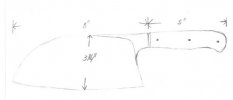- Joined
- Dec 4, 2001
- Messages
- 3,824
A customer requested a cleaver for cutting meat. That's all the info I've got to work with. It'll be used for BBQ cutting meat.
I'm thinking of 3/16th thick about 6" blade full flat grind with convex edge, Loveless style handle with brass or stainless thin bolsters. Not sure yet wether to use stainless or carbon steel, haven't pened him down yet. I'd personaly prefere stainless for a kitchen knife, probably ATS-34, or maybe CPM 154 cm.
Never made a cleaver before, any ideas, opions?
Thanks
I'm thinking of 3/16th thick about 6" blade full flat grind with convex edge, Loveless style handle with brass or stainless thin bolsters. Not sure yet wether to use stainless or carbon steel, haven't pened him down yet. I'd personaly prefere stainless for a kitchen knife, probably ATS-34, or maybe CPM 154 cm.
Never made a cleaver before, any ideas, opions?
Thanks



